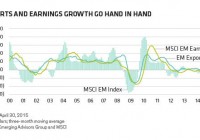Are EM Stocks Finally Emerging?
It seems as if in every client meeting lately, I’m getting questions about emerging market (EM) stocks. Many investors are looking for that magic bottom and are wondering if it’s time to step back in, while others are wondering if we’ll see further declines due to commodity weakness and eventual Federal Reserve (Fed) tightening. These questions come as EM stocks have had a rollercoaster year , with valuations beaten up by concerns about China’s economy , slowing global growth and lower commodity prices , just to name a few of the headwinds facing developing markets. According to Bloomberg data, by the end of the third quarter, the MSCI Emerging Markets Index was down 15 percent year to date. However, since then, emerging markets have reversed course , with the index gaining roughly 5 percent since the last day of the third quarter, according to Bloomberg data as of November 9. Of course, this ride has been rocky as well, with the index rallying following news implying a Fed delay, like the weak September jobs report, and then losing steam in early November after upbeat October jobs data increased expectations of a December hike. So, is this the beginning of an EM rally? Or are the gains since the third quarter just a temporary bounce? I believe it’s too early to call a recovery. A look at what has caused the volatile advance helps to explain why. First, a little primer on what typically happens to EM investments when a Fed rate rise is imminent. When markets believe the Fed will raise rates in the short term, investors generally add exposure to U.S. assets as they search for higher returns and potentially stronger currencies, rather than explore EM investments and their generally higher risk. In contrast, when Fed action is delayed, as has been the case this fall, flows have generally gone in the opposite direction, based on Bloomberg data. Investors increase risk exposure for potential return, adding exposure to EM equities and other risky assets. This is what seems to be the catalyst for the fourth-quarter EM rally. Unfortunately, as EM data accessible via Bloomberg testify, it hasn’t been driven by signs of economic improvement, firming inflation or rising earnings. Rather, it’s been primarily a reaction to the Fed’s delay in September, and the belief that the Fed would not raise rates until 2016. But when investors believe the Fed will, in fact, raise rates sooner than that, they may very well reduce their EM exposure. We saw this in early November, when a positive labor market report caused investors’ expectations of the probability of a Fed hike in December to rise from 56 percent on November 5 to roughly 70 percent the following day as measured by the pricing of federal funds futures, according to Bloomberg. EM stocks sold off on the news, with the index down roughly 4 percent since November 5, based on Bloomberg data as of November 9. Whether a Fed rate rise comes before December 31 or not, it’s likely to come eventually. In addition, many EMs are forecasted to continue to experience weak economic growth and geopolitical issues. So while EM valuations are relatively cheap, they may remain cheap for some time, and could even get cheaper from here. So what does this mean for portfolios? With valuations cheaper than they have been in over a decade, patient long-term investors may want to consider slowly building back benchmark buy-and-hold positions . But while broad exposure to the asset class can help diversify risk, it’s also important to remember that EM stocks aren’t a homogenous asset class. In our latest Investment Directions monthly market commentary , my investment strategist colleagues and I highlight select EM countries where we see potential opportunities right now, including South Korea. Exchange traded funds such as the iShares core MSCI Emerging Markets ETF (NYSEARCA: IEMG ) and the iShares MSCI Emerging Markets Minimum Volatility ETF (NYSEARCA: EEMV ) can provide exposure to broad emerging markets, while exchange traded funds such as the iShares MSCI South Korea Capped ETF (NYSEARCA: EWY ) can provide access to South Korea. This post originally appeared on the BlackRock Blog.
